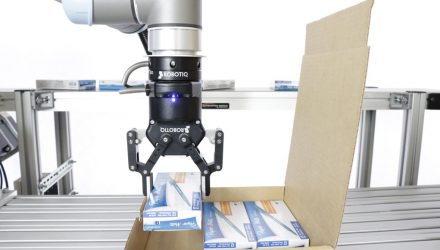Packing is one of the most common tasks in logistics.
4. Robot Palletizing
One example of tertiary packaging is palletizing. It’s well suited to robots because it generally involves repetitive actions and items that are too heavy for humans to lift.
There are even specialized palletizing robots: these are usually robotic arms that have five degrees of freedom (DoF) and a sixth DoF that can rotate more than 360 degrees, so that the robot can properly orient items onto pallets. There are also many programming solutions to simplify robot palletizing, such as the UR palletizing wizard.
For more information, see Pallets + Robots = a Competitive Advantage?.
5. Robotic Ports
One of the newest robotic-logistic applications is robotic ports. These aren’t USB or Ethernet ports—they’re where cargo is loaded onto boats.
We first heard about robotic ports back in May when a Chinese port was made fully robotic. The port was designed by TuSimple, a self-driving-truck startup. It uses autonomous cranes and self-driving container vehicles to perform all the functions of a cargo port, but with no humans on site.
6. Self-Driving Vehicles
With the rapid advances made in the past few years, autonomous trucks are the most obvious example of self-driving technology. Other applications include autonomous forklifts, delivery vehicles, and mobile parcel stations (like mailboxes on wheels).
As with the TuSimple port, China seems to be a driving force (if you’ll excuse the pun) for autonomous logistics vehicles. As SingularityHub says, “Dozens of autonomous truck startups are reported to have launched in China in the past two years.”
For details on how self-driving vehicles can improve manufacturing, see Self-Driving Vehicles Quick to Replace AGVs.
7. Last Mile Drone Delivery
Last mile delivery is (as the name suggests) the last step in the logistics journey from manufacturer to end customer. Although drone delivery has received a lot of media attention, drones aren’t the only robots being tested at this stage. Other recent developments include autonomous ground, super-size, and four-legged delivery robots.
For more information, including a description of the first-ever successful pizza delivery by drone, see Top 5 Ways Robotics Is Changing the Food Industry.
8. Container Loading and Unloading
Container loading is like palletizing, but instead of piling products onto a pallet, it involves pulling packages out of a shipping container. As a result, the handling requirements are slightly different, since the robot must be able to hold products from the side. One example of such a system is the IRIS project, which seeks to use vision and self-learning to improve packing.
9. Sorting
Sorting is essential at many stages of logistics. But it has traditionally been challenging for robots, which require advanced sensing to differentiate between various products. However, the necessary capabilities are easier to acquire than ever before thanks to vision sensors like the Robotiq Wrist Camera.
10. Collaborative Robot Packing
As you know if you’ve been following the Robotiq blog, cobots are on the rise in many industries, and logistics is no different. Collaborative packing lets humans and cobots work together: the robot can take over the more mundane, repetitive actions, while humans handle the more delicate tasks.
For more trends in robotics and artificial intelligence, visit the Robotics & AI Channel.
